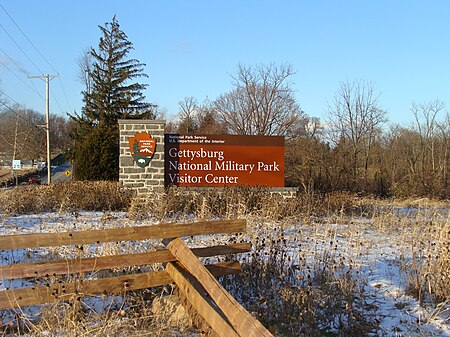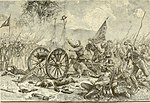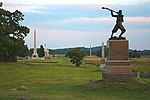Gettysburg National Military Park

The Gettysburg National Military Park protects and interprets the landscape of the 1863 Battle of Gettysburg during the American Civil War. Located in Gettysburg, Pennsylvania, the park is managed by the National Park Service. The GNMP properties include most of the Gettysburg Battlefield, many of the battle's support areas during the battle (e.g., reserve, supply, and hospital locations), and several other non-battle areas associated with the battle's "aftermath and commemoration," including the Gettysburg National Cemetery. Many of the park's 43,000 American Civil War artifacts are displayed in the Gettysburg Museum and Visitor Center.The park has more wooded land than in 1863, and the National Park Service has an ongoing program to restore portions of the battlefield to their historical non-wooded conditions, as well as to replant historic orchards and woodlots that are now missing. In addition, the NPS is restoring native plants to meadows and edges of roads, to encourage habitat as well as provide for historic landscape. There are also considerably more roads and facilities for the benefit of tourists visiting the battlefield park. Attendance in 2018 was 950,000, a decline of 86% since 1970. The five major Civil War battlefield parks operated by the National Park Service (Gettysburg, Antietam, Shiloh, Chickamauga/Chattanooga and Vicksburg) had a combined 3.1 million visitors in 2018, down 70% from 10.2 million in 1970.The park was added to the National Register of Historic Places on October 15, 1966.
Excerpt from the Wikipedia article Gettysburg National Military Park (License: CC BY-SA 3.0, Authors, Images).Gettysburg National Military Park
Gilliland Alley,
Geographical coordinates (GPS) Address Nearby Places Show on map
Geographical coordinates (GPS)
| Latitude | Longitude |
|---|---|
| N 39.808611111111 ° | E -77.236666666667 ° |
Address
Gettysburg National Military Park
Gilliland Alley
17325
Pennsylvania, United States
Open on Google Maps









